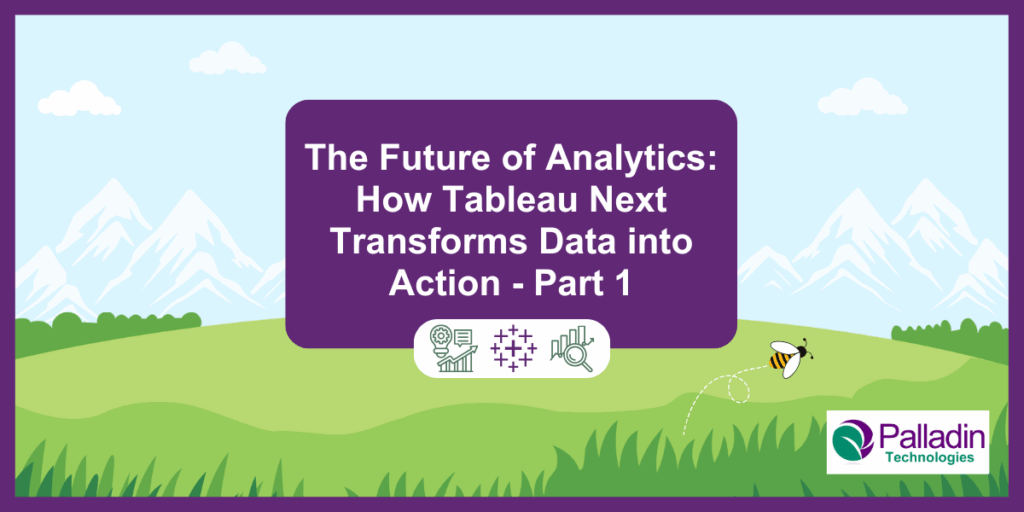Picture this: Your organization has more data than ever before. Dashboards are everywhere. Analytics tools are running 24/7. Yet somehow, making critical business decisions still feels like navigating in the dark. Sound familiar? You’re not alone.
Despite having access to mountains of information, many companies find themselves “data rich and insight poor”—a paradox that’s been frustrating business leaders for years. But what if there was a way to bridge that gap? Enter Tableau Next, Salesforce’s bold vision for the future of analytics.
The Analytics Paradox: Why More Data Doesn’t Mean Better Decisions
For over two decades, Tableau has been championing the democratization of analytics, helping business users transform raw data into compelling visual stories. When Salesforce acquired Tableau in 2019, it seemed like a perfect match, combining Salesforce’s customer-first approach with Tableau’s industry-leading BI platform.
Yet even today, with 96% of business leaders acknowledging that analytics is critical to success, organizations continue to struggle with fundamental challenges:
Data lives in silos. Marketing has its numbers, sales have theirs, and operations have yet another set. Getting a unified view feels impossible.
Trust is in short supply. When every department defines “customer conversion” differently, which metric do you believe? Teams spend more time arguing about the numbers than acting on them.
Critical insights slip through the cracks. Without the ability to connect disparate data sources, organizations miss game-changing opportunities hiding in plain sight.
Everything gets rebuilt from scratch. Analysts become digital archaeologists, constantly recreating analyses that should be reusable across teams.
This inefficiency doesn’t just waste resources—it fundamentally undermines the promise of data-driven decision making.
Meet Tableau Next: Where AI Meets Analytics
Announced in early 2025, Tableau Next represents a fundamental shift in how we think about business intelligence. This isn’t just about prettier charts or faster queries. It’s about creating what Salesforce calls “agentic analytics”—a world where AI agents and human users collaborate seamlessly to turn data into decisive action.
Tableau Next is a flexible, API-first analytics experience that integrates the #1 analytics platform with Agentforce, the world’s first digital labor platform. Built on a composable architecture, with a unified data layer and trusted semantics, it delivers personalized, contextual, and actionable insights to every user.
Think of it as having a brilliant data scientist sitting next to every business user, ready to answer complex questions, generate insights, and recommend next steps—all grounded in trusted, enterprise-grade data.
The Technical Architecture That Changes Everything
What makes Tableau Next revolutionary isn’t just its AI capabilities—it’s the thoughtful, layered architecture that addresses analytics’ core challenges. Tableau Next is natively built on the Salesforce Platform, bringing together the best of Salesforce and Tableau for a seamless analytics experience. With the power of Salesforce’s Hyperforce cloud infrastructure, it delivers enterprise-grade security, compliance, scalability, and governance.
The Data Layer: Data Cloud Foundation. Powered by Hyperforce and with Data Cloud as the unified data layer, Tableau Next ensures enterprise-grade security, compliance, and agility while seamlessly unifying customer data for analysis. This layer consolidates information from across your organization, breaking down those infamous data silos once and for all.
Technical Connectivity: Tableau Next’s data layer is powered by Data Cloud, meaning it supports the same connectors as Data Cloud. Tableau Next will support a robust set of live and direct connectors, including Snowflake, Google BigQuery, Amazon Redshift, Databricks, PostgreSQL, MySQL, and more. Additional connectors, such as SQL Server (Cloud AWS live and ingest) are planned for future releases. Beyond these connectors, Tableau Next enables direct ad hoc ingestion of CSV and Excel files within the authoring experience.
The Semantic Layer: Tableau Semantics. Perhaps the most game-changing component is Tableau Semantics, a powerful AI-infused semantic layer integrated into Data Cloud that translates your data into your business language. With an intuitive UI, built-in AI assistance, and agent enrichment capabilities, Tableau Semantics infuses your data with business knowledge, driving more accurate responses and relevant insights.
A Semantic Model is a structured framework that defines how business data is organized and interpreted for a specific use case. It acts as a container for semantic definitions, bringing together Data Cloud Objects, relationships, calculations, and metadata to create a standardized and business-friendly representation of key terms and metrics.
Technical Implementation: The semantic layer consists of two main technical components:
- Semantic Data Models (SDMs): A semantic data model contains the entities that define your business terms. For example, the definition of a metric like “revenue” is sourced from certain data sources, the relationships between them, specific join types, and a formula that defines how it’s calculated.
- Semantic Query Generator: As the heart of Tableau Semantics, this service takes business questions from apps, dashboards, widgets, or APIs, and uses semantic definitions to translate them into SQL. This ensures that queries align with the specific meaning behind business terms like “revenue,” “last quarter,” or “by region.”
Performance Architecture: The team chose a SQL generator-based approach for the semantic layer query execution engine instead of building our own query processor. This strategic decision allows us to leverage the scalability and optimization features of underlying data warehouses, avoiding the need to reinvent performance tuning.
The Visualization Layer: This delivers the beautiful, flexible dashboards Tableau is famous for, but now they’re built on a foundation of unified, trusted data. Open, interoperable, and API-first, it brings insights to everyone in every workflow.
The Actionability Layer: Agentic Analytics. Tableau Next integrates natively with Agentforce, and comes with out-of-the-box analytics skills – Data Pro, Concierge, and Inspector – putting agentic AI at the heart of this new analytics experience. This goes beyond showing you what happened to recommending what you should do next. It’s the difference between a rearview mirror and a GPS system.
Bridging the Gap Between Insight and Action
Tableau Next is more than just the next evolution of a familiar platform. It is a strategic response to the persistent challenges facing modern analytics. By unifying data sources, applying semantic clarity, and delivering trusted, reusable insights, it creates a strong foundation for confident and consistent decision-making. In Part 2, we will explore how Tableau Next builds on this foundation with AI-powered analytics skills, real-time intelligence, and a technical infrastructure designed to turn potential into performance—at scale.
Learn More About Partnering With Us!
Vice President, AI & Specialized Services
Astha Panchal is the VP of AI & Specialized Services at Palladin Technologies, where she leads innovation across AI, data management, DevOps, and quality assurance. With nearly 20 years in the software industry, she drives AI-powered solutions and ensures operational excellence across all service lines. A hands-on expert in MDM, data integration, and platform architecture, Astha has guided complex digital transformations and data-driven initiatives. She holds multiple certifications across Salesforce, Vlocity, and MuleSoft.
Having served as Developer, Architect, Team Lead, and Practice Director, Astha brings a comprehensive perspective to her role. She is passionate about fostering growth, innovation, and a culture of continuous learning within her teams.

